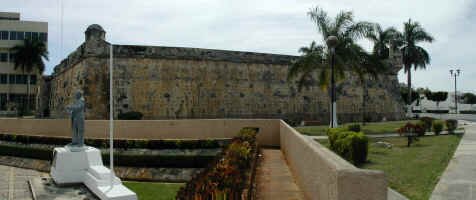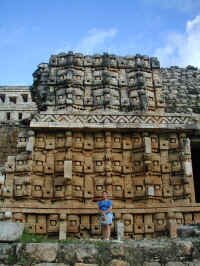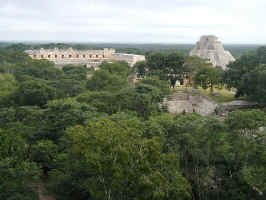November 17, 2004
We spent the night at a "camping" just outside the "outer" gates of Bonampak. In the morning we walked to the entrance and paid for transport to the "inner" entrance. We had never visited a park before that had a perfectly usable road and that you were charged a fee ($7.00USD) for someone else to drive you on. We determined that this was a way for the Lacandons to bring some extra money into their economy, so if this would help them live without logging the jungle, we were all for it.
Bonampak is a relatively small archeological site, but it has some really magnificent murals. Evidently the original murals were in pretty good condition when they were discovered, but the people researching them used kerosene to help bring out the colors in the murals that were found in the temples. This evidently had only a temporary effect and it caused the murals to start flaking off the walls. When we saw them, they looked pretty good, so someone must have come up with a new method of restoring and salvaging them.
| In one of the buildings that was "discovered" completely intact, the murals we found were absolutely stunning! They covered every square inch of the walls and the ceiling, and the three doorways had carved limestone blocks as the lentils over the doorways. |
After our visit, we caught our ride back to the entrance and walked back to our campsite. After lunch we headed off toward the town of Frontera Corrazal to catch a "loncha" to the ruins of Yaxchilan. Yaxchilan is located on a bend in the river that cannot be reached by road. The only way to get there is by boat. Again, the Lacandon people have the franchise for taking people anywhere on the river. We think that they were given these rights as an incentive to move out of their ancestral homes in the jungle when the area became a Reserve – but this didn’t stop landless Mexicans from moving into the jungle and cutting it down.
We were hoping to catch a ride with a tour group as part of a collectivo as the cost to hire an entire boat would be $50.00USD. Because of the amount of time needed for transport (an hour each way) and time at the ruins (2 hours min.) we decided we would have to catch a ride before 1:30pm in order to do the ruins properly. Well, since most of the tours arrive in the morning, we were out of luck until the next day. No problem. The river area was interesting with boats and vendors and there were howler monkeys in the trees right across the river. Boy, do they live up to their names. They are amazingly loud! And the Lacandons who run the boats let us camp for free.
November 18, 2004
This morning we were up early, hoping to catch an early tour group and share their boat to the ruins. We were in luck and we were able to join a group of French tourists with a guide who spoke Spanish, French and English. On our ride to the ruins, we spotted two crocodiles and lots of birds. Arriving at the ruins, we hurried on ahead after noting with the tour guide the time we needed to return to the boat. We really enjoy viewing these sites by ourselves without hordes of tourists pushing and shoving. And today was wonderful. The setting in the jungle was beautiful, there were spider and howler monkeys playing in the trees and the ruins with their carved lintels were just amazing.
One of the most interesting buildings at the site was called La Laberinto (the labyrinth) and it had subterranean rooms and pathways which is something we’ve never seen before. It was like walking in a man-made cave complete with bats.
Our boat ride back upstream took an hour and was equally as interesting as the ride down.
Back at the dock, we said goodbye to our boatmates and after having lunch, hit the road for the 3-hour drive back toward Palenque.
November 19, 2004
After a quiet night in a campground surrounded by big trees we were able to spend some time in the morning birdwatching and running errands. We saw a lot of the common grackles, but we also saw a vermillion flycatcher, a red crested woodpecker, kiskadees, snowy egrets and a very large hawk that we were unable to identify at a distance.
After finishing up some grocery shopping and visiting the internet café, we were again on the road toward Sabancuy where there are miles and miles of deserted white sand beaches fronted by blue/green ocean. We found a spot and settled in for a day of rest. Along the way we passed through a couple of towns where we saw young boys dressed up like Pancho Villa, complete with bandoleros. This was a very interesting sight – then we realized that the next day was November 20th the day Francisco Madero called for revolution against the dictatorship of Porfirio Diaz, and yes, Pancho Villa helped during the Mexican revolution.
November 20-21, 2004
After a day of beachcombing and swimming we headed off toward Campeche. The city itself is attractive as the buildings are painted with bright colors, even the buildings that are just shells, no longer having roofs. The main reason to stop here is to explore the ruins of the forts and walls that were built late in the 1600’s to protect the city from pirates.
It was interesting to see the walls (some of which had been recently rebuilt) and try to picture them protecting the town. Now the walls are in the middle of roadways and several hundred meters from the waterfront – so a lot of imagination was required to picture it.
We found a nice restaurant overlooking the zocalo to have lunch and people watch for a while. Our guide book gave a description of the cathedral stating that on Sundays the late comers to mass would all gather around the entrance – and sure enough we saw the people participating in services while standing outside of the church.
Finding our campsite at the end of the day proved to be more challenging than normal. While following the directions in our guidebook, we got to within a block of the site and were stymied by cars parked on either side of the road, blocking anything larger than a tiny car from passing through. There were parties going on on both sides of the street, so Kim went door to door looking for car owners, while Don sat in the street periodically honking the horn. After a few minutes of this and cars backing up in both directions, the police showed up and made us start backing up. This was difficult in that there was very little room and we were already skimming the electrical wires above. But back up we did. That allowed the little tiny cars through but it still didn’t allow the police pickup truck through either. Finally the two car owners came out to move their cars and we were able to proceed. Thus is part of the fun of driving in Mexico.
November 22, 2004
Today we headed off to visit a couple of sets of ruins. The first was at Edzna, about an hour and a half southeast of Campeche. This is a "minor" ruin but we thoroughly enjoyed wandering around its well-kept grounds and observing the iguanas that have made it their home. There were only a couple of other sets of tourists there so it was very pleasant. This site is the first site that we have seen in the Puuc style of architecture and one of the highlights are the masks (face carvings) of Chac, the god of rain. The mask at Edzna was on an inner wall of a small building and still had some of its original red paint adorning it.
One of the buildings was a five story high pyramid that had rounded edges, similar to what we expect to find at Uxmal. The steps were VERY steep, but Don decided that he just had to see the view from the top. After climbing, the view was outstanding as the pyramid was the tallest building in sight, and you could see all the way to the horizon.
Leaving Edzna we continued down the road toward Kabah. The road was not very heavily traveled but it was very narrow. There were only a couple of extra inches on either side of the vehicle when completely centered within the lane. This is a little unnerving when the vehicle coming toward you in the other lane is a bus and they are either completely taking up their lane or a little in your lane. This is not an unusual occurrence but it certainly takes a toll on your nerves by the end of the day.
As we drive on these narrow roads, every few days we come upon truck accidents. These aren’t multiple vehicle crashes as you might expect, but rather accidents where these huge tractor-trailer rigs have simply run off the road and flipped over. We saw another one today and the tow trucks where waiting to get to work on it.
| Arriving at Kabah we were treated to the main building covered with masks of Chac. Chac is the Mayan God of water. Over 300 of them according to the guidebook. Some of the characteristics of these masks were long curving noses and open mouths with teeth. They also had ear openings with ornamental ear plugs. |
As the sun was setting, we left Kabah and headed off toward Uxmal for the night. The guard at the gate let us spend the night in the parking lot so we would be ready bright and early for exploring the next morning.
November 23, 2004
Uxmal is one of the premier archeological sites to see in Mexico and we were not disappointed. Given the fact that water is scarce in the area, it is amazing that such a large city could have flourished here. But the Maya were ingenious. They created a series of holding tanks to gather the rain that does fall, thus ensuring themselves a water supply. The city flourished from 600AD to 900AD when it was abandoned.
The huge Piramide del Adivino (Pyramid of the Magician) is no longer open to climbing and it appeared that archeologists were doing some excavation in it. On one side of the pyramid, workers had numbered every single stone, and then removing them – it looked like they were intending to tunnel right into it! The pyramid itself is built on an oval base and has been rebuilt 5 times with the first four temples completely covered by the fifth.
The Cuadrangulo de las Monjas (the Nunnery) takes its name from the rows of door openings along its four sides, but it might actually have been a school or palace complex. The long nosed face of Chac appears everywhere on the facades as do snakes, owls and geometric designs.
Another of the interesting buildings includes the Casa de las Tortugas with its display of carved turtles.
After our visit to Uxmal we headed back to the coast to the town of Celestun to visit the flamingos that make this area their home from November to April.
Celestun sits on a spit of land between the Rio Esperanza and the ocean. This area has a very large ocean lagoon which attracts thousands of flamingos to its waters every year. We joined another couple in hiring a boat from the beach that took us down the coast, past American Pelicans (white birds that are less common than the Brown Pelican), ospreys, herons, egrets and suddenly, flamingos! Not expecting to see them on the ocean side, we were caught by surprise. We were able to beach the boat and approach them on foot, but we were unable to get very close, because as soon as we did they would start moving away. Back in the boat, we stopped to view what the guide called "the petrified forest". This was an area of trees that had died 120 years ago when a change in either the weather or land caused the area to sink and inundated the trees with salt water. It was an eerie looking landscape.
Finally making it back into the lagoon, we came upon a large shallow area where a large group of flamingos was gathered. We were able to get closer this time, but the sound of the boat engine distresses the birds and boat captains don’t want to disturb them (with reason).
Seeing how close the birds were to the bridge that crosses the lagoon, we decided that tomorrow we would see if we could kayak closer to them.
November 24, 2004
We got up early this morning and headed to the bridge. Looking north to where we saw the flamingos yesterday, we were shocked to see about a hundred of them even closer! Hurrying to get the kayak in the water before the tourist boats scared up the birds, we unloaded, inflated and slathered sunscreen in record time. Paddling quickly but quietly we approached the sand spit where the birds were feeding. When they first noticed us they lifted their heads from feeding and started to walk away. But because the water is so shallow we were able to place our paddles into the muck and sit in one spot. This allowed the birds to get used to us and settle back into their routine of scooping the muck and sifting it for crustaceans, insects and plant matter.
The birds periodically would get closer or move away as sounds and food would catch their interest. They typically would be about 25 feet away and completely ignoring us. We sat with them for about an hour listening to their sounds and watching their movements, until a large truck going by on the bridge startled them into flight and they moved off about a quarter mile to a new spot. This was one of the most wonderful wildlife experiences we’ve had and one we will never forget.


